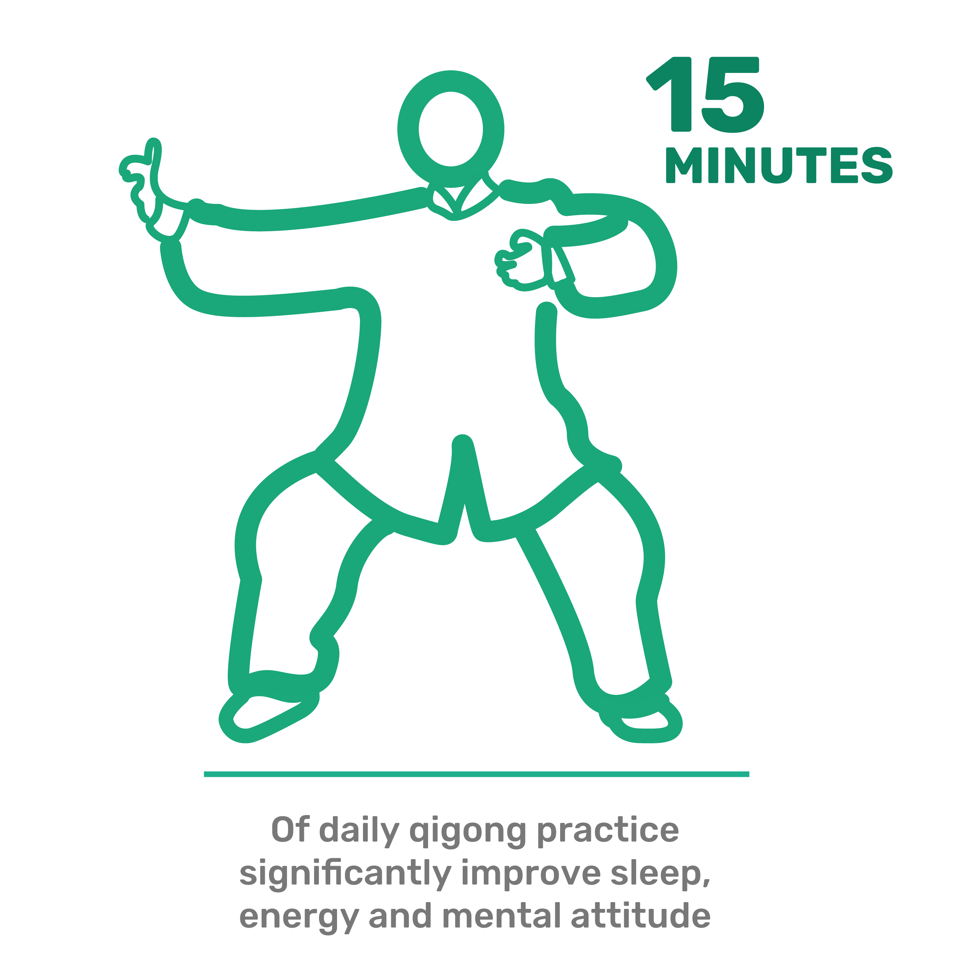Qigong
Qigong is a 4,000 year old Chinese practice of healing which works with the body, breath, and mind.
Qigong consists of flowing movements combined with deep breathing and a meditative state of mind to remove energy blockages and increase harmonious energy flow.
The movements performed in Qigong stretch and strengthen the muscles and improve balance and flexibility. They involve slow rhythmic moves mirroring those found in nature, such as the lapping of water or blowing of wind. The central principle of Qigong is to feel connected with our deepest core and with the larger whole of the universe.
“Qi” is the Chinese word for energy and “Gong” means cultivation or skill that is cultivated through steady practice. “Qigong” means “cultivating the body’s vital energy” to heal and strengthen the body and mind.
There are three main branches of Qigong:
- Medical
- In Traditional Chinese Medicine (TCM), Qigong can be used to heal particular ailments
- It can be internal or external and involves five steps: meditating, cleansing, strengthening, circulating and dispersing Qi
- Spiritual
- To increase self-awareness and insight
- Martial art
- For protection of self and others
Mental health benefits of Qigong

Craske, N. J. M., Turner, W., Zammit-Maempe, J., & Lee, M. S. (2009). Qigong Ameliorates Symptoms of Chronic Fatigue: A Pilot Uncontrolled Study. Evidence-Based Complementary and Alternative Medicine : eCAM, 6(2), 265–270. https://www.hindawi.com/journals/ecam/2009/749612/abs/
The deep breathing exercises, meditations and slow movements can help:
- Calm and center the mind
- Reduce stress, anxiety, and tension
- Aid sleep
- Foster creativity
- Boost mood
- Enhance cognitive capability
- Help balance the nervous system
- Help balance hormones
- Help balance neurotransmitters
- Help detoxification by circulating blood and lymph
Qigong can help with the following mental health symptoms:
- Anxiety
- Stress
- Depression
- Sleep issues
- Addictions
- Cognitive issues
- Fatigue
Abbott, R. and Lavretsky, H. (2014). Tai Chi and Qigong for the Treatment and Prevention of Mental Disorders. [online] Psychiatric Clinics of North America, 36 (1), pp. 109-19. Available at: https://www.ncbi.nlm.nih.gov/pmc/articles/PMC3917559/ [accessed 12 Sept. 2017]., http://www.qigonghealing.com/qigong/whatis.html, https://www.livescience.com/38192-qigong.html
Qi gong breathing practices
There are many different types of breathing practice in Qigong, but three of the most basic are:
Natural breathing describes the type of breathing that we typically use throughout the day:
- When we inhale, our diaphragm contracts and pulls downward, pushing the belly out, and the lungs expand
- When we exhale, the diaphragm automatically relaxes back up into a dome shape, air leaves the body, and the belly contracts inward
The breath should be slow, deep, fine, and even. This allows our body and cells to take in more oxygen and release more carbon dioxide, which leads to many health benefits such as lowering of blood pressure, slowing the heart rate, and faster detoxification.
Reverse breathing can be a useful practice before meditation. As the name suggests, it can be considered in some ways as the reverse of natural breathing.
To try reverse breathing:
- Inhale deeply, contract your abdomen and fill the upper part of your lungs
- When you exhale, push your abdomen out, and drop your breath within the body
- Because of the decrease of pressure in the lungs (increase of volume) the diaphragm will move down, and the organs in the abdomen will contract
Everyone has used this type of breathing, whether consciously or not. It is the way we instinctively breathe when pushing something heavy. The breath moves vertically, up and down within the body, like a pump. Interestingly, during reverse breathing, the breath also moves horizontally, moving backwards and forwards inside the belly during exhalation.
It is important that any advanced breathing techniques be learned and practised under the supervision of an experienced teacher. Over-practice or incorrect practice can cause side effects: too much downward pressure on the lower abdomen can cause haemorrhoids, and too much upward pressure on the stomach can contribute to acid reflux. Reverse breathing is not recommended for those with high blood-pressure.
“Dantian” is usually roughly translated as “elixir field” since it is considered a valuable energy center, a place of healing.
There is a very important acupuncture point on the lower spine called the “Gate of Life” which can be stimulated by Dantian breathing, as can the kidneys. In Chinese medicine, when the kidneys are stimulated, our entire body’s vitality and energy will improve.
While there are three major Dantian in the body, the one referred to in Dantian breathing is the lower Dantian, a major energy center found slightly under and behind the navel.
In Dantien breathing, the lower back is incorporated into deep breathing breathing practice. To practice Dantien breathing:
- Focus the mind on the Dantian while keeping the chest relaxed
- Expand the abdomen and lower back on the inhale, and contract on the exhale
- When you exhale, you can gently pull up the pelvic floor